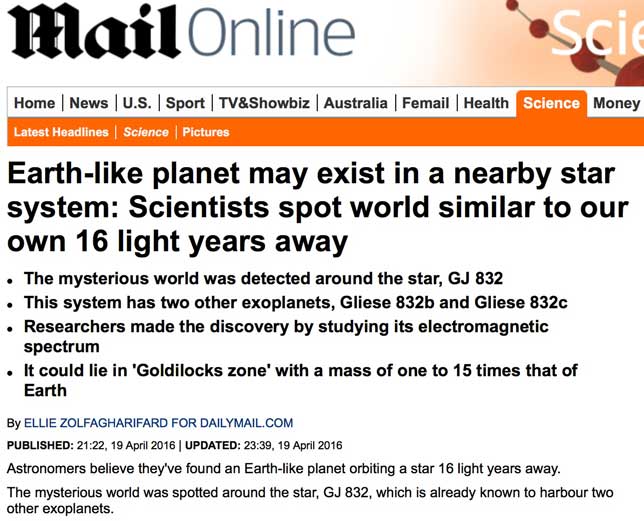If you read the Daily Mail, then you might indeed be tempted to think that another earth-like planet had been discovered. The Daily mail within its “Science” section has all the exciting details ..
 There is one ever so tiny detail here that may be worth pointing out, it is not actually true. The term “Scientists Spot” is not factual, and it is the words “May Exist” that perhaps offers the clue here that things are not quite as presented. It is true that a recent paper has been published, but what that paper is all about is not an actual discovery of an earth-like planet and is instead about something else.
There is one ever so tiny detail here that may be worth pointing out, it is not actually true. The term “Scientists Spot” is not factual, and it is the words “May Exist” that perhaps offers the clue here that things are not quite as presented. It is true that a recent paper has been published, but what that paper is all about is not an actual discovery of an earth-like planet and is instead about something else.
Incidentally, this is not a dig at the Daily Mail, the Express story is no better, their headline starts …
“Planet colonisation BREAKTHROUGH: Earth-like planet may be nearby“
So what is the real discovery here?
If you ignore the Daily Mail and instead go back to the actual scientific paper, then what you discover is that a very small tiny step has been taken.
Basically after crunching the numbers they conclude …
Stability of planetary orbits around GJ 832 star system, which contains inner (GJ 832c) and outer (GJ 832b) planets, is investigated numerically and the detailed phase-space analysis are performed. ….
…Then, the radial velocity curves based on the signature from the Keplerian motion are generated for the Earth-like planet to estimate its distance from the star and its mass-limit. The synthetic RV signal suggests that an additional planet (1M? ? mass ? 15M?) with dynamically stable configuration may be residing between 0.25 – 2.0 AU from the star. We have provided an estimated number of RV observations for the additional planet for further observational verification.
In other words, they have reviewed the available data which enabled them to conclude that there are two planets within the GJ 832 star system, and conducted numerical simulations to examine the possibility that there may be other planets between the two they already know about. The distance between the two known planets is vast, one is very near the star at 0.16 AU (Gliese 832c, an super-earth about 15 times the size of Earth), and the other is a Jupiter gas giant at 3.53 AU. (For reference, an AU is the average distance between the Sun and our Earth).
These distances for the two GJ 832 planets were both worked out using the radial velocity method which is as follows …
The radial velocity method to detect exoplanets is based on the detection of variations in the velocity of the central star, due to the changing direction of the gravitational pull from an (unseen) exoplanet as it orbits the star. When the star moves towards us, its spectrum is blueshifted, while it is redshifted when it moves away from us. By regularly looking at the spectrum of a star – and so, measuring its velocity – one can see if it moves periodically due to the influence of a companion.
OK, so that initial data is the starting point here and they can then feed all that into simulations and see if it hints at the possibility of a third earth like planet. Now given that they have observational data (the radial velocity observations), then it needs to fit that available data (obviously). The conclusion is that there is a possibility that there might be something there.
Key Point: This is all hypothetical, they have not actually verified that there is anything there, but have instead simply verified that it is a possibility.
OK, but why is this exciting or even interesting?
The point is this – the goal here was not to actually look, but rather to work out where to look and how big it might be. If you are looking for the preverbal needle in a haystack, then knowing such details makes it far more probable that you will find it. This is one small step that increases the tools that astronomers have to explore what is out there.
To actually confirm this they would still need many more radial velocity observations, or perhaps transit method studies, or even direct images (The James Webb Space Telescope which is due for launch in Oct 2018 introduces that possibility) but at least starting with an understanding that this is a real possibility within that star system means they know that it is worth spending valuable time and resources looking there – and that is really what this is all about.